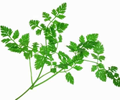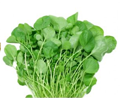
Basil
Basil, originally from India, is best known as a culinary herb. Basil is a highly fragrant plant whose leaves are used as a seasoning herb for many different types of foods. Basil has round leaves that are oftentimes pointed.

Basil – Thai
Thai basil, or Asian basil is a type of sweet basil native to Southeast Asia that has been cultivated to provide distinctive traits. Its flavor is more stable under high or extended cooking temperatures than that of sweet basil.

Bay Leaf
The bay leaf is oval, pointed and smooth, 2.5 – 8 cm (1 to 3 in) long. When fresh, the leaves are shiny and dark green on top with lighter undersides. When dried the bay leaf is a matte olive green.

Chives
Chives are hollow, long, narrow stems attached to a bulb on one end and tube-shaped green leaves at the other. Chives are used fresh or dried. The entire length of the tubular leaf is used in foods. Chinese chives have flat and wider stems than regular chives.

Chives – Garlic
Also known as Chinese chives, garlic chives (Allium tuberosum), can be used and stored in the same manner as chives. They are distinguishable from chives by their flat, broader leaves and fragrant white flowers.

Coriander
Coriander leaves have pungent smell described by some as “soapy” The stems also have a strong odour and flavour.

Chervil
That subtle, tender flavor-part anise, part parsley-that you’ve been trying to identify in the fish sauce, will almost certainly turn out to be chervil, the most retiring of the sister spices that make up the fines herbes of French cuisine, but one that’s good company and not to be overlooked.

Dill
The seed is light brown, winged and oval, with one side flat, with two ridges. The other side is convex with three ridges and three oil channels. Seeds are about 3.5 mm (0.15 in) long. The leaves and stalks are aromatic and are used fresh or for pickling.

Mint
Mint leaves are deep green, long , pointed and crinkled. Pennyroyal has small oval leaves, greyish in colour.

Mint – Vietnamese
A very invasive creeping/climbing perennial in the same family as knotweed and quite similar in appearance. It grows to about 80cm tall. The pointed leaves are stem-clasping and patterned with chocolate brown markings which are more noticeable when it is grown in full sun. Small pink flowers appear in summer. The leaves have a very strong hot minty flavour.

Marjoram
Marjoram leaf is used fresh, as whole or chopped, and dried whole or broken, and ground. The flowering tops and seeds, which are not as strong as the leaves, are also used as flavorings. Sweet marjoram is a small and oval-shaped leaf. It is light green with a greyish tint.

Oregano
This perennial herb forms a low creeping mound. The soft, lime green leaves are highly aromatic and the plant can also be used to good effect in the ornamental garden where it makes an attractive ground cover. It bears small white flowers but these are unremarkable.

Parsley
The curly type, Petroselinum crispum, is aptly named for the clean, fresh, crispy taste of the tightly bunched, bright green leaves. This crispiness is one of parsley’s best attributes, adding texture and colour when added just before serving.

Parsley – Continental
The second common variety of parsley, flat leafed or Italian parsley (Petroselinum neapolitanum) has a more delicate sawtoothed leaf pattern which does not hold up as well for garnishing.

Roquette
A herb of the mustard family, with pungently flavored leaves often eaten in salads.

Rosemary
Rosemary has one of those distinctive, strong flavours that convinces the palate that herbs aren’t just delicate things reserved for dainty soups and sprinkling on baby vegetables. It takes hold of the taste buds with a woodsy flavour, somewhat piny, mintlike yet sweeter, with a slight ginger finish.

Sage
While some people may find the pungency of sage overpowering, its astringent, ‘grease-cutting’ attributes make it a perfect accompaniment to fatty foods such as pork, goose and duck.

Sorrel
Sorrel has large, light to dark green, oblong-shaped, spinachlike leaves. It comes as fresh or frozen and chopped or whole. Its taste ranges from a refreshing, sharply acidic, or astringent spinachlike taste with bitter notes to a milder, lemony taste. The younger leaves are less acidic.

Tarragon
This aromatic perennial is grown for its distinctively flavoured leaves. Flowers: Yellow or greenish white; small, globe-shaped; in terminal panicles; rarely fully open and usually sterile. Leaves: Linear to lanceolate, undivided; 1-4 in. long

Thyme
Thyme tastes delicately green with a faint clove aftertaste, It ranks as one of the fines herbes of French cuisine. Leaves and sprigs are used in salads as garnishes and most famously in clam chowder, bouquets garnis, and French, Creole, and Cajun cuisines.

Thyme – Lemon
Lemon Thyme is a variable hybrid, with lemon scented, oval to lance-shaped leaves and pale lilac flowers.Leaf-like bracts appear in interrupted whorls in summer.

Watercress
The watercress leaflets or clusters of leaves are enjoyed fresh. Dried leaves do not have the flavor as fresh leaves do. With garden cress, the flowers and unripe fruits, too, are eaten. Watercress has a crunchy texture which is appealing for salads.


